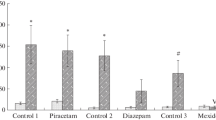Summary
Dogs, rhesus monkeys and rats were trained to avoid electric shock by using different discrete conditioned avoidance response procedures. Chlorpromazine selectively blocked avoidance behavior in the rat, but non-selectively blocked both avoidance and escape behavior in the dog and monkey. Morphine was selective against avoidance behavior in the rat but was inactive in the dog and monkey. Pentobarbital and meprobamate non-selectively blocked both avoidance and escape performance in all three species. These data, when compared with literature reports, support the conclusion that selective antiavoidance activity is not an intrinsic property of the chlorpromazine or morphine molecule.
Similar content being viewed by others
References
Cook, L., and R. T. Kelleher: Effects of Drugs on Behavior. Ann. Rev. Pharmacol. 3, 205–222 (1963).
—, and E. Weidley: The behavioral effects of some psychopharmacological agents: Ann. N. Y. Aoad. Sci. 66, 740–752 (1957).
Dews, P. B., and W. H. Mouse: Behavioral pharmacology. Ann. Rev. Pharmacol. 1, 145–174 (1961).
Domino, E. F., A. J. Karoly, and E. L. Walker: Effects of various drugs on a conditioned avoidance response in dogs resistant to extinction. J. Pharmacol. exp. Ther. 141, 92–99 (1963).
Herz, A.: Drugs and the CAR. Int. Rev. Neurobiol. 2, 229–272 (1960).
Litchfield, J. T., Jr., and F. Wilxocon: A simplified method of evaluating dose-effect experiments. J. Pharmacol. exp. Ther. 96, 99–113 (1949).
Pfeiffer, O. C., A. J. Riopelle, R. P. Smith, E. H. Jenney, and H. L. Williams: Comparative study of the effect of meprobamate on the conditioned response on strychnine and pentylenetetrazole Thresholds on the normal electroencephalogram, and on polysynaptic reflexes. Ann. N. Y. Acad. Sci. 67, 734–743 (1957).
Samuel, G. K., J. K. Kodama, and J. H. Mennear: Effects of scopolamine and atropine and their quaternized salts on avoidance behavior in the monkey. Psychopharmacologia (Berl.) 8, 295–301 (1965).
Sidman, M.: Behavioral pharmacology. Psychopharmacologia (Berl.) 1, 1–19 (1959).
Smith, R. P., A. I. Wagman, W. Wagman, C. C. Pfeiffer, and A. J. Riopelle: Effects of some tranquilizing and depressant drugs on conditioned avoidance behavior in the monkey. J. Pharmacol. exp. Ther. 119, 317–323 (1957).
Verhave, T., J. E. Owen, Jr., and E. B. Robbins: Effects of chlorpromazine and secobarbital on avoidance and escape behavior. Arch. int. Pharmacodyn. 116, 545–553 (1958).
Author information
Authors and Affiliations
Rights and permissions
About this article
Cite this article
Clark, R., Samuel, G.K. Drug effects on a discrete conditioned avoidance response in dogs, rhesus monkeys and rats. Psychopharmacologia 14, 106–114 (1969). https://doi.org/10.1007/BF00403683
Received:
Revised:
Issue Date:
DOI: https://doi.org/10.1007/BF00403683




